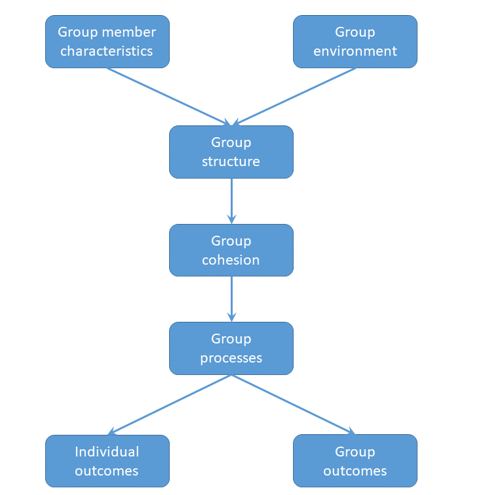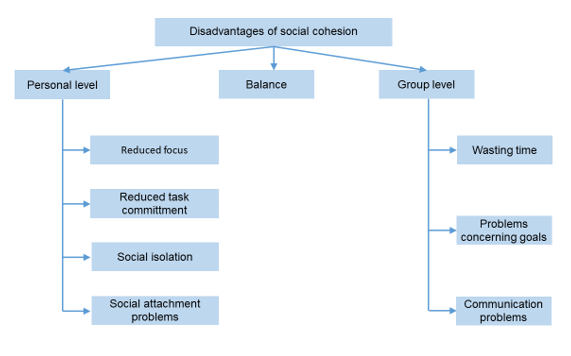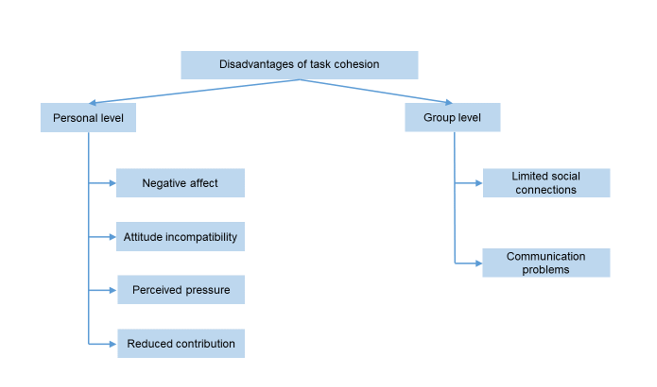5. Study of the behavior of groups in sport
The (social)psychological knowledge gathered about groups apply for sport teams as well, but sport teams have certain characteristics that require specific approach. The emergence of group processes and group behavior in sport is outlined in Figure 1. based on Carron and Hausenblas (1998).

Figure 1: The emergence of group processes and group behavior in sport (based on Carron and Hausenblas, 1998).
Group cohesion
As can be seen in Figure 1, group cohesion is in the focus of the behavior of groups in sport. Group cohesion as a central factor when it comes to the success of teams is recognized since the beginning of time, but since the ancient Greeks for sure. The first written proof that the success of a team was attributed to the unity and cohesion of the group was in case of the 300 Spartan warrior battling with the Persian army at Thermopylae. (Siebold, 1999, cited by Carron, Shapcott & Burke, 2008.)
Solidarity and cohesion often occur when it comes to explain unexpected results, or performances as well. Let’s just take Leicester City as an example who won the championship title in the 2015/2016 Premier League season. (This was a big surprise given the fact that the Foxes who work with a significantly smaller budget as compared for example to the Great Four clubs - Manchester United, Manchester City, Liverpool, Arsenal -, and also lack real star players, were able to win the PL.) This kind of shocking (and in a sense euphoria provoking) performance is to be attributed to the common effect of a number of different factors, but when explaining this great achievement group cohesion appears almost every time as a key factor of the success.
As a counterexample Paris Saint Germain can be mentioned (or even Manchester City from the Premier League), who cannot reach a really salient achievement despite the fact that they have a huge budget as compared to most of the other teams, and they employ a great number of star players.
The central position of group cohesion in the investigation of groups and specifically sport teams is important because this feature is related to, or affect several other characteristics, it is so salient part of group dynamics that many researchers consider this feature the most defining feature of a group.
Carron et al. (1998, p. 213) defined group cohesion as “a dynamic process which is reflected in the tendency for a group to stick together and remain united in the pursuit of its instrumental objectives and/or for the satisfaction of member affective needs”.
According to Carron et al. (2014) the following four characteristics are considered important:
multidimensional: depending on the group, a number of pretty different factors plays a role in that the group remains intact
dynamic: cohesion is not necessarily stable over time
instrumental: include and express the reasons that play a role in the group taking shape and staying together
affective: cohesion is associated with positive effect
The relation of group cohesion and sport relevant factors
As it has been mentioned above, group cohesion is one of the major research fields of sport psychology, and there are a number of factors that proved to have a relation with it in numerous studies. Below an overview of the relation between group cohesion and different other factors is provided based on Carron et al. (2008).
Environmental factors
Of the numerous environmental factors two were identified to show a relation with group cohesion, namely, size of the group and level of competition. As a general relation it can be stated that the more members are in a group, the lower the level of group cohesion is, that is, a reverse relation is found between cohesion and group size. This reverse relation can most likely be attributed to the fact that as the number of group members increases there is less possibility for interaction and effective coordination between the group members.
Level of competition was among others studied by Granito and Rainey (1988) who found a reverse relation between level of competition and group cohesion in an investigation involving high school and college basketball teams. The likely explanation of the results may be as the level of competition increases the consensus regarding common goals and social unity is considerably harder to be reached. This result can be linked to the above-mentioned phenomenon, that cohesion in teams “lacking” great stars may be higher, because social unity and consensus about the goals may be easier to be established.
Personal factors
Of the many personal factors investigated in connection with group cohesion two proved to be relevant, just as in case of the environmental factors: personal satisfaction and commitment. For example, Martens and Peterson (1971) found that basketball teams showing a high degree of group cohesion, experienced a higher degree of personal satisfaction according to self-reports of the players. The results, corroborated by the study by Williams and Hacker (1982) in which causality was the subject of study, that there is a relation between personal satisfaction, group cohesion and performance, and these factors mutually strengthen one another.
Leadership
In connection with leadership the behavior and decision making style of the leader (coach) was found to be important for group cohesion. Result of the investigations show that the social support from the leader, democratic leadership style and the use of positive feedback increase the level of cohesion in the team. Moreover, democratic leadership style proves to be the most successful, that is, resulting in higher level of cohesion when it comes to handling situations where decision making is involved. In teams where the members of the team are more included in decision making report higher levels of team cohesion.
Team-related factors
There are several factors which are characteristic of the team as a whole and related to group cohesion.
One of these characteristics is role unambiguity that is in positive relation with group cohesion, the more clearly articulated the roles are, the higher the level of group cohesion.
Similar to role unambiguity, conformity, that is, obeying, following group norms is also positively related to group cohesion based on the study results. Schachter et al., for example, found that in groups characterized with high level of cohesion obeying to group norms was higher, irrespective of if the norm of performance was high or low.
Another important factor linked with the team is collective efficacy that can be considered as the team equivalent of self-efficacy, that expresses how much the members of the team perceive the team as having the resources and competencies required to successfully solve the tasks, and how much the team is capable of allocating the available resources and coordinate the tasks. Study results show that group cohesion is in positive relation with perceived group efficacy, and based on some studies (e.g., Heuze, Raimbault & Fontayne, 2006) group efficacy acts as a mediator variable between group cohesion and group performance.
Group size is also an important, although not extensively investigated factor that may be related with group cohesion. The phenomenon was investigated by Widmeyer, Brawley, and Carron (1990, idézi Russel, 1993), for example, who studied basketball and volleyball teams of different sizes. They investigated emerging group cohesion in 3, 6, and 9 person basketball and 3, 6 and 12 person volleyball teams. As had been hypothesized, with the increase in group size the cohesion experienced in the teams decreased for both basketball and volleyball teams.
In coeducated groups the above results were somewhat modulated in that for women larger groups are more attractive, while for men group size does not play a role in the attractiveness of the team (Marshall & Heslin, 1975). On the other hand, given that in team sports homogeneous teams are involved, this result is less relevant.
Group cohesion and group performance
In sports, mainly in competitive ones performance is a key issue. In team sports a naturally occurring decisive factor of team performance is group cohesion. This issue has been addressed in numerous studies, that was analyzed and summarized by Carron, Colman, Wheeler and Stevens (2002). In their meta-analysis they analyzed 164 effect sizes of 46 publications.
The main question of the meta-analysis was if there was a relation between group cohesion and performance in sport. As a result of the analysis of the 164 effect sizes a significant moderate to strong correlation was found between these variables.
The more detailed analysis of the results showed that social cohesion had the largest effect on the performance, larger than task cohesion or a general cohesion coefficient, although these differences did not prove to be significant, that is, in the analyzed publications there were no differences among the cohesion measures, as far as their relation with performance is concerned. Similar findings were obtained in the analyses when experience as a moderator variable was taken into account, effect sizes did not differ significantly, independent of whether the results of professional or amateur sportsmen were investigated.
Beyond the analysis of the general relation between group cohesion and performance the effect of several mediator variables were investigated. The difference in the cohesion-performance relation between coactive sports (like rowing, for example), where interactions are not needed that much and interactive sports (like football, for example) did not prove to be significant. Likewise, no differences were found in the effect sizes when performance was measured based on self-reports or observing behavior.
Investigations of gender differences, on the other hand, showed significant differences, effect sizes were significantly larger in case of sportswomen, than in case of sportsmen.
Disadvantages of high group cohesion
Although group cohesion is identified as one of the most important factors in the relevant literature, and it is considered to be positive for the group (team), in certain circumstances the high level of group cohesion may become a disadvantage as well. In their study, Hardy, Eys and Carron (2005), investigated if there could be negative outcomes of high group cohesion based on the perception of sportsmen involved in team sports, and if the answer is positive, how it is emerging. Based on the perception of 105 sportsperson from various levels, high level of group cohesion may have not only positive effects on the team, but negative ones as well. The most prominent negative consequences of the high level of social cohesion and task cohesion can be seen in Figure 2 and Figure 3, respectively.

Figure 2: Most prominent disadvantages of social cohesion (based on Hardy, Eys és Carron, 2005).

Figure 3: Most prominent disadvantages of task cohesion (based on Hardy, Eys és Carron, 2005).